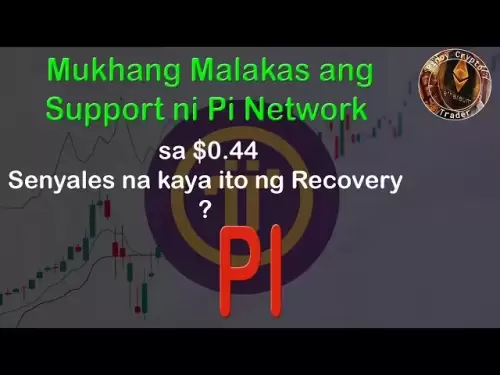-
 Bitcoin
Bitcoin $108,708.8110
0.60% -
 Ethereum
Ethereum $2,561.6057
1.91% -
 Tether USDt
Tether USDt $1.0001
-0.03% -
 XRP
XRP $2.2795
0.57% -
 BNB
BNB $662.2393
1.00% -
 Solana
Solana $153.1346
3.74% -
 USDC
USDC $1.0000
0.00% -
 TRON
TRON $0.2877
0.97% -
 Dogecoin
Dogecoin $0.1710
3.93% -
 Cardano
Cardano $0.5871
1.61% -
 Hyperliquid
Hyperliquid $39.6663
1.68% -
 Sui
Sui $2.9032
0.79% -
 Bitcoin Cash
Bitcoin Cash $496.1879
1.71% -
 Chainlink
Chainlink $13.5807
3.01% -
 UNUS SED LEO
UNUS SED LEO $9.0777
0.61% -
 Stellar
Stellar $0.2514
4.51% -
 Avalanche
Avalanche $18.1761
1.86% -
 Shiba Inu
Shiba Inu $0.0...01173
1.72% -
 Toncoin
Toncoin $2.8010
-4.23% -
 Hedera
Hedera $0.1594
3.21% -
 Litecoin
Litecoin $87.0257
-0.53% -
 Monero
Monero $319.1217
1.79% -
 Polkadot
Polkadot $3.3853
0.68% -
 Dai
Dai $0.9999
-0.01% -
 Ethena USDe
Ethena USDe $1.0003
0.02% -
 Bitget Token
Bitget Token $4.3420
-0.97% -
 Uniswap
Uniswap $7.3772
1.39% -
 Aave
Aave $286.6277
5.61% -
 Pepe
Pepe $0.0...09994
2.33% -
 Pi
Pi $0.4589
1.76%
What does the surge in the number of large transactions on SUI's chain mean?
Surge in large SUI transactions signals shifts in market dynamics, potentially affecting liquidity, price volatility, and network activity on the blockchain.
Apr 25, 2025 at 03:57 pm
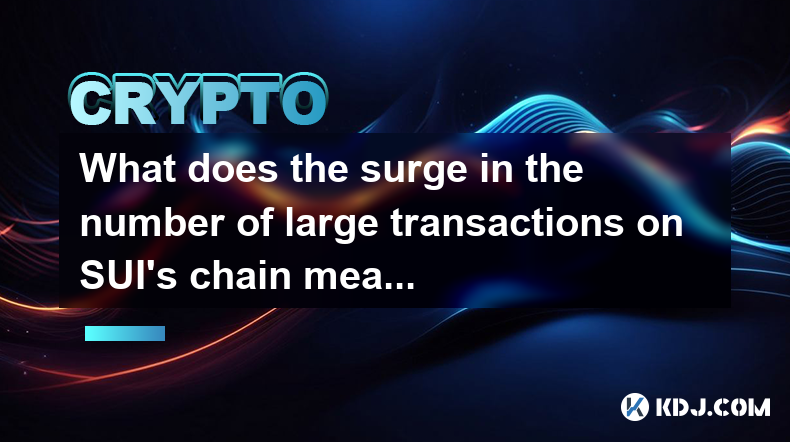
The surge in the number of large transactions on SUI's chain is a significant event within the cryptocurrency ecosystem, indicating various underlying trends and shifts. In this article, we will delve into the meaning behind this surge, exploring its implications for the SUI blockchain, its users, and the broader crypto market.
Understanding Large Transactions on SUI
Large transactions on the SUI blockchain refer to transfers of significant amounts of SUI tokens. These transactions are often monitored because they can provide insights into the behavior of large investors, commonly known as "whales," and institutional investors. When there is a noticeable increase in the number of these transactions, it typically suggests a shift in market dynamics.
Indicators of Market Sentiment
A surge in large transactions can be an indicator of market sentiment. When whales and institutional investors move large sums of SUI tokens, it often reflects their confidence or lack thereof in the future value of the asset. For instance, an increase in large transactions could signal that these investors are accumulating SUI, expecting its price to rise. Conversely, if the surge is accompanied by a price drop, it might indicate selling pressure from these large holders.
Impact on Liquidity and Price Volatility
The increase in large transactions can have a direct impact on the liquidity of SUI tokens. When whales and institutional investors engage in significant buying or selling, it can lead to higher liquidity, making it easier for smaller investors to trade. However, this can also result in increased price volatility. Large transactions can cause rapid price movements, as the market reacts to the actions of these major players.
Influence on Network Activity
A surge in large transactions also affects the overall network activity of the SUI blockchain. Higher transaction volumes can lead to increased network congestion, which may result in higher transaction fees and slower processing times. This can be both a challenge and an opportunity for the SUI network, as it strives to handle increased demand while maintaining efficiency.
Potential for Increased Adoption
The increase in large transactions can be a sign of increased adoption of the SUI blockchain. When more significant players in the crypto space start using SUI for their transactions, it can attract more attention and investment from other market participants. This can create a positive feedback loop, where increased adoption leads to further growth and development of the SUI ecosystem.
Analyzing the Data
To understand the surge in large transactions on SUI's chain, it's crucial to analyze the data in detail. Here are some steps to consider when examining this phenomenon:
- Identify the Source: Determine whether the large transactions are coming from known wallets associated with whales or institutional investors. This can provide context about the nature of the transactions.
- Track Transaction Patterns: Look for patterns in the timing and frequency of these large transactions. Are they occurring at specific times or in response to market events?
- Correlate with Market Data: Compare the surge in large transactions with other market indicators, such as price movements, trading volume, and market sentiment indices.
- Monitor On-Chain Metrics: Use on-chain analytics tools to monitor other metrics like active addresses, transaction fees, and network congestion. These can provide a more comprehensive view of the network's health and activity.
Case Studies of Large Transactions on SUI
To illustrate the impact of large transactions, let's look at a few case studies from the SUI blockchain:
- Case Study 1: Whale Accumulation: In one instance, a known whale wallet was observed making multiple large transactions, accumulating a significant amount of SUI tokens over a short period. This led to a subsequent increase in SUI's price, as other investors followed suit, expecting further growth.
- Case Study 2: Institutional Investment: A major institutional investor announced its entry into the SUI ecosystem, marked by a series of large transactions. This not only boosted the token's price but also increased its visibility and credibility in the market.
- Case Study 3: Market Correction: In another scenario, a surge in large transactions was followed by a sharp price drop. Analysis revealed that these transactions were part of a broader market correction, where whales and institutional investors were selling off their holdings to realize profits.
Implications for SUI Token Holders
For existing SUI token holders, the surge in large transactions can have several implications:
- Price Movements: Holders should be prepared for potential price volatility, as large transactions can lead to rapid price changes.
- Market Sentiment: Monitoring the sentiment behind these large transactions can help holders make informed decisions about whether to hold, buy, or sell their tokens.
- Network Health: Increased network activity can be a double-edged sword, potentially leading to higher fees and slower transactions. Holders should stay updated on the network's performance.
Strategies for Navigating Large Transaction Surges
Given the potential impact of large transactions, SUI token holders and investors can adopt several strategies to navigate these surges:
- Diversification: Spreading investments across different cryptocurrencies can mitigate the risk associated with large transaction-induced volatility.
- Staying Informed: Regularly monitoring market news and on-chain analytics can provide early warnings about significant transactions and their potential impact.
- Using Stop-Loss Orders: Setting stop-loss orders can help protect against sudden price drops triggered by large transactions.
- Participating in Governance: Engaging in the SUI network's governance processes can provide insights into upcoming developments and potential impacts on large transaction volumes.
Frequently Asked Questions
Q: How can I track large transactions on the SUI blockchain?
A: To track large transactions on the SUI blockchain, you can use various blockchain explorers and on-chain analytics platforms. These tools allow you to filter transactions by size and monitor specific addresses associated with whales and institutional investors.
Q: Are large transactions always a sign of positive market sentiment?
A: Not necessarily. While large transactions can indicate accumulation and positive sentiment, they can also signal selling pressure and potential price drops. It's essential to analyze the context and other market indicators to understand the true sentiment behind these transactions.
Q: How does the SUI network handle increased transaction volumes?
A: The SUI network employs various mechanisms to handle increased transaction volumes, such as dynamic fee adjustments and network upgrades. These measures aim to maintain network efficiency and user experience even during periods of high demand.
Q: Can retail investors benefit from tracking large transactions on SUI?
A: Yes, retail investors can benefit by gaining insights into market trends and potential price movements. By understanding the actions of large investors, retail investors can make more informed decisions about their SUI holdings.
Disclaimer:info@kdj.com
The information provided is not trading advice. kdj.com does not assume any responsibility for any investments made based on the information provided in this article. Cryptocurrencies are highly volatile and it is highly recommended that you invest with caution after thorough research!
If you believe that the content used on this website infringes your copyright, please contact us immediately (info@kdj.com) and we will delete it promptly.
- Bitcoin Wallet Hack? Coinbase Exec Sounds the Alarm on $8B Whale Movement
- 2025-07-07 18:30:12
- Mercado Bitcoin, Tokenization, and XRP Ledger: A Latin American Power Play
- 2025-07-07 18:30:12
- XYZVerse, Wall Street, and the Crypto Upswing: What's the Deal?
- 2025-07-07 19:10:12
- AI, Web3, and Communities: Building the Future Together
- 2025-07-07 19:10:12
- AurealOne: A Promising Early-Stage Metaverse Project
- 2025-07-07 19:15:12
- Dogecoin Price: Crypto Market Analysis and the Musk Effect
- 2025-07-07 19:50:12
Related knowledge
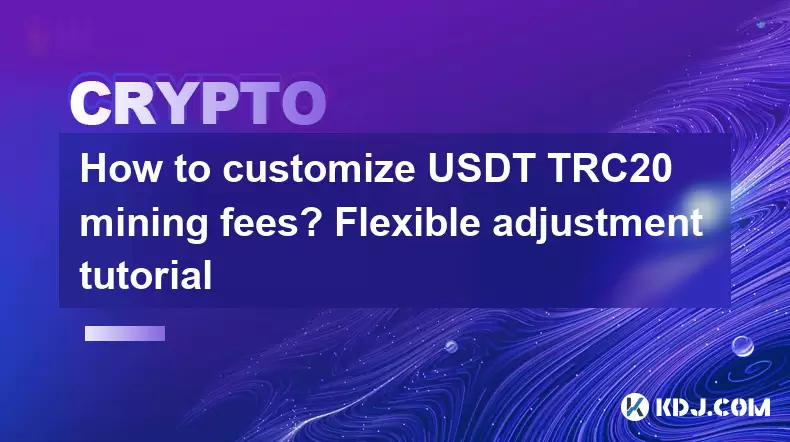
How to customize USDT TRC20 mining fees? Flexible adjustment tutorial
Jun 13,2025 at 01:42am
Understanding USDT TRC20 Mining FeesMining fees on the TRON (TRC20) network are essential for processing transactions. Unlike Bitcoin or Ethereum, where miners directly validate transactions, TRON uses a delegated proof-of-stake (DPoS) mechanism. However, users still need to pay bandwidth and energy fees, which are collectively referred to as 'mining fe...
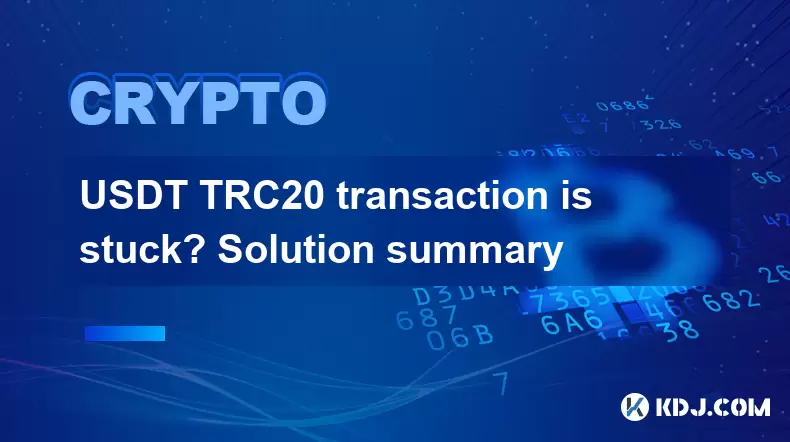
USDT TRC20 transaction is stuck? Solution summary
Jun 14,2025 at 11:15pm
Understanding USDT TRC20 TransactionsWhen users mention that a USDT TRC20 transaction is stuck, they typically refer to a situation where the transfer of Tether (USDT) on the TRON blockchain has not been confirmed for an extended period. This issue may arise due to various reasons such as network congestion, insufficient transaction fees, or wallet-rela...
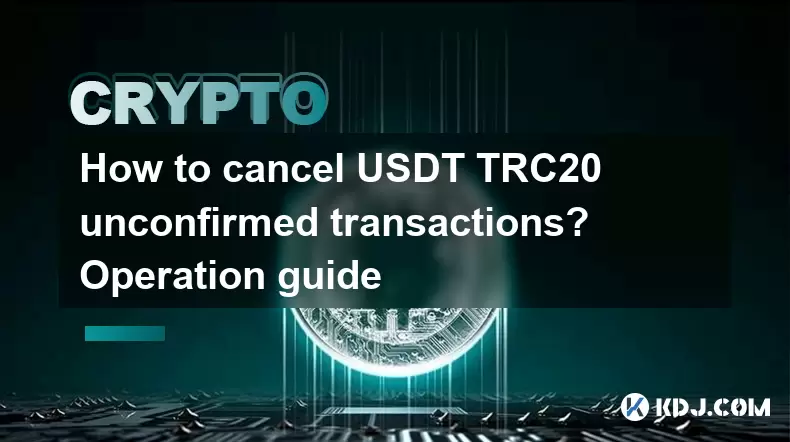
How to cancel USDT TRC20 unconfirmed transactions? Operation guide
Jun 13,2025 at 11:01pm
Understanding USDT TRC20 Unconfirmed TransactionsWhen dealing with USDT TRC20 transactions, it’s crucial to understand what an unconfirmed transaction means. An unconfirmed transaction is one that has been broadcasted to the blockchain network but hasn’t yet been included in a block. This typically occurs due to low transaction fees or network congestio...
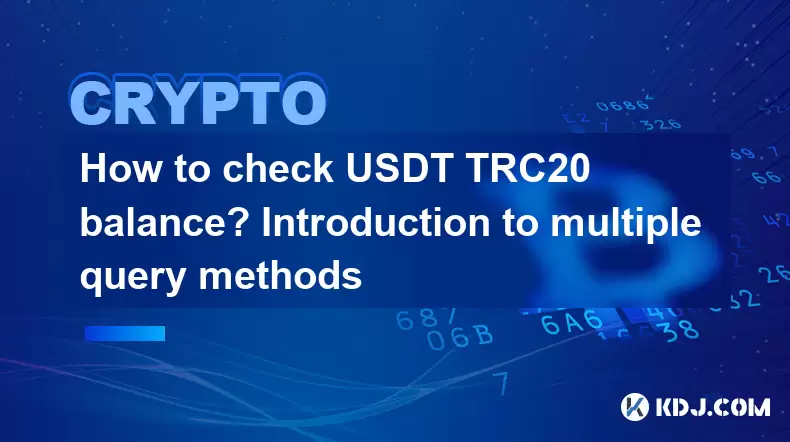
How to check USDT TRC20 balance? Introduction to multiple query methods
Jun 21,2025 at 02:42am
Understanding USDT TRC20 and Its ImportanceUSDT (Tether) is one of the most widely used stablecoins in the cryptocurrency market. It exists on multiple blockchain networks, including TRC20, which operates on the Tron (TRX) network. Checking your USDT TRC20 balance accurately is crucial for users who hold or transact with this asset. Whether you're sendi...
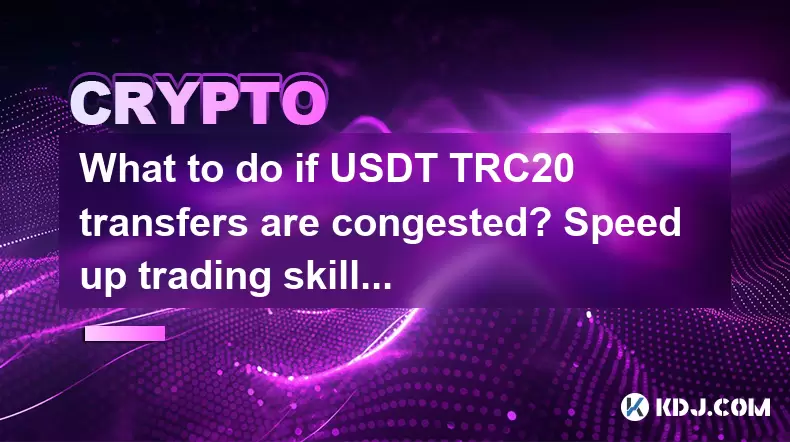
What to do if USDT TRC20 transfers are congested? Speed up trading skills
Jun 13,2025 at 09:56am
Understanding USDT TRC20 Transfer CongestionWhen transferring USDT TRC20, users may occasionally experience delays or congestion. This typically occurs due to network overload on the TRON blockchain, which hosts the TRC20 version of Tether. Unlike the ERC20 variant (which runs on Ethereum), TRC20 transactions are generally faster and cheaper, but during...
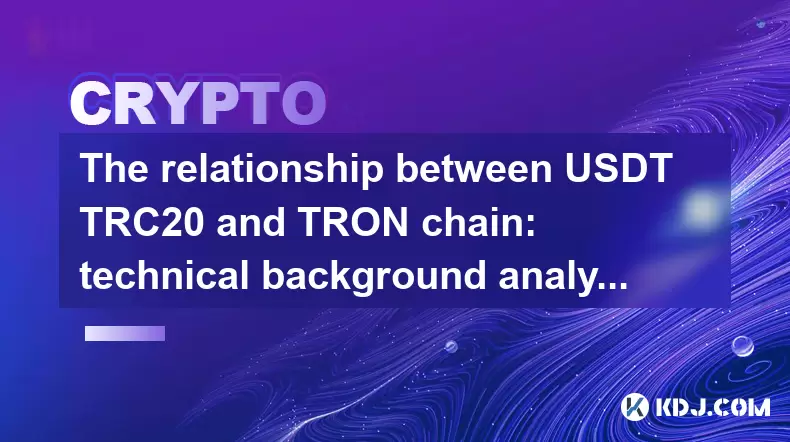
The relationship between USDT TRC20 and TRON chain: technical background analysis
Jun 12,2025 at 01:28pm
What is USDT TRC20?USDT TRC20 refers to the Tether (USDT) token issued on the TRON blockchain using the TRC-20 standard. Unlike the more commonly known ERC-20 version of USDT (which runs on Ethereum), the TRC-20 variant leverages the TRON network's infrastructure for faster and cheaper transactions. The emergence of this version came as part of Tether’s...

How to customize USDT TRC20 mining fees? Flexible adjustment tutorial
Jun 13,2025 at 01:42am
Understanding USDT TRC20 Mining FeesMining fees on the TRON (TRC20) network are essential for processing transactions. Unlike Bitcoin or Ethereum, where miners directly validate transactions, TRON uses a delegated proof-of-stake (DPoS) mechanism. However, users still need to pay bandwidth and energy fees, which are collectively referred to as 'mining fe...

USDT TRC20 transaction is stuck? Solution summary
Jun 14,2025 at 11:15pm
Understanding USDT TRC20 TransactionsWhen users mention that a USDT TRC20 transaction is stuck, they typically refer to a situation where the transfer of Tether (USDT) on the TRON blockchain has not been confirmed for an extended period. This issue may arise due to various reasons such as network congestion, insufficient transaction fees, or wallet-rela...

How to cancel USDT TRC20 unconfirmed transactions? Operation guide
Jun 13,2025 at 11:01pm
Understanding USDT TRC20 Unconfirmed TransactionsWhen dealing with USDT TRC20 transactions, it’s crucial to understand what an unconfirmed transaction means. An unconfirmed transaction is one that has been broadcasted to the blockchain network but hasn’t yet been included in a block. This typically occurs due to low transaction fees or network congestio...

How to check USDT TRC20 balance? Introduction to multiple query methods
Jun 21,2025 at 02:42am
Understanding USDT TRC20 and Its ImportanceUSDT (Tether) is one of the most widely used stablecoins in the cryptocurrency market. It exists on multiple blockchain networks, including TRC20, which operates on the Tron (TRX) network. Checking your USDT TRC20 balance accurately is crucial for users who hold or transact with this asset. Whether you're sendi...

What to do if USDT TRC20 transfers are congested? Speed up trading skills
Jun 13,2025 at 09:56am
Understanding USDT TRC20 Transfer CongestionWhen transferring USDT TRC20, users may occasionally experience delays or congestion. This typically occurs due to network overload on the TRON blockchain, which hosts the TRC20 version of Tether. Unlike the ERC20 variant (which runs on Ethereum), TRC20 transactions are generally faster and cheaper, but during...

The relationship between USDT TRC20 and TRON chain: technical background analysis
Jun 12,2025 at 01:28pm
What is USDT TRC20?USDT TRC20 refers to the Tether (USDT) token issued on the TRON blockchain using the TRC-20 standard. Unlike the more commonly known ERC-20 version of USDT (which runs on Ethereum), the TRC-20 variant leverages the TRON network's infrastructure for faster and cheaper transactions. The emergence of this version came as part of Tether’s...
See all articles























